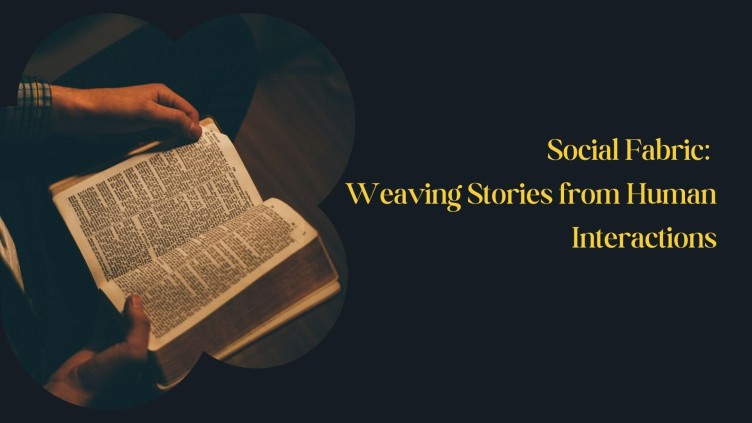Welcome to another deep dive into the intricate and fascinating world of human connections here on Riya’s Blogs! In this article, we’ll unravel the concept of “Social Fabric” and explore how our interactions weave the rich, complex tapestry of human society. For those of you who are new, you can find more of these thought-provoking discussions on Riya’s Blogs.
What is Social Fabric?
Imagine the social fabric as a vast, intricate quilt made up of countless threads—each thread representing an individual, and the fabric itself embodying the collective essence of human society. Social fabric is a term used to describe the network of relationships, norms, values, and social structures that bind individuals together within a community or society. It is through these threads that our stories, traditions, and social norms are woven.
In essence, the social fabric is what keeps our communities together, shaping our interactions and influencing how we perceive and relate to one another. It encompasses everything from the deep bonds between family members to the casual connections we make with strangers in our daily lives.
The Threads of Human Interaction
1. Family Ties: The Strongest Threads
Family is often the first and most significant thread in the social fabric. These relationships provide us with a sense of identity and belonging, shaping our early experiences and perceptions of the world. The strength of family ties can influence our social behavior, values, and even our mental health. Family interactions, whether supportive or strained, play a pivotal role in defining the fabric of our lives.
2. Friendships: The Colorful Patterns
Friendships add color and texture to the social fabric. These connections, built on shared interests and experiences, enrich our lives and provide emotional support. Friendships can be fleeting or lifelong, but they all contribute to the vibrant patterns that make up our social quilt. They offer us different perspectives, challenge our viewpoints, and often help us grow.
3. Community Bonds: The Weave of Local Life
Communities form the larger structure of the social fabric. Local interactions, from neighborhood gatherings to community service, weave together individuals into a cohesive group. These bonds are strengthened through shared experiences, collective goals, and mutual support. Community involvement fosters a sense of belonging and encourages social responsibility.
4. Workplace Connections: The Professional Threads
Our professional lives contribute another layer to the social fabric. Workplace interactions, whether collaborative or competitive, influence our social behavior and professional identity. Positive work relationships can enhance job satisfaction and productivity, while conflicts can create challenges. The way we navigate these professional threads affects not only our careers but also our broader social interactions.
5. Digital Networks: The Modern Weave
In today’s digital age, online interactions have become a significant part of the social fabric. Social media platforms, online forums, and virtual communities allow us to connect with people across the globe. While these digital threads can expand our social network and provide new opportunities, they also bring challenges such as digital etiquette and the impact of virtual interactions on real-life relationships.
The Impact of Social Fabric on Society
1. Cultural Identity and Continuity
The social fabric plays a crucial role in preserving and transmitting cultural identity. Traditions, customs, and social norms are passed down through generations, creating a sense of continuity and belonging. By participating in cultural practices and maintaining social rituals, individuals contribute to the preservation of their cultural heritage.
2. Social Support and Well-being
A strong social fabric provides a network of support that enhances individual well-being. From emotional support during difficult times to practical help in daily life, the connections within the social fabric can significantly impact mental and physical health. Research has shown that strong social ties are linked to lower stress levels, better health outcomes, and overall life satisfaction.
3. Social Change and Innovation
Social fabric is not static; it evolves with time and societal changes. The interactions within the social fabric can drive social change and innovation. For instance, movements for social justice, environmental sustainability, and technological advancements often emerge from collective efforts and shared goals within the social fabric.
4. Conflict and Resolution
While the social fabric can be a source of strength, it can also be a battleground for conflicts. Differences in values, beliefs, and interests can lead to tensions within the social fabric. However, these conflicts can also serve as opportunities for dialogue, understanding, and resolution, ultimately leading to a more resilient and cohesive society.
Weaving Your Own Social Fabric
As we explore the nuances of social fabric, it’s important to consider how we contribute to and shape our own social networks. Here are some ways you can positively influence your social fabric:
1. Foster Meaningful Connections
Invest time and effort in building and maintaining meaningful relationships. Whether with family, friends, or colleagues, prioritize genuine interactions and show appreciation for those around you.
2. Engage in Your Community
Get involved in local activities and community projects. Your participation helps strengthen community bonds and creates a positive impact on the social fabric of your area.
3. Practice Empathy and Understanding
Approach interactions with empathy and an open mind. Understanding different perspectives and respecting diverse viewpoints contribute to a more inclusive and harmonious social fabric.
4. Embrace Digital Opportunities
Use digital platforms to connect with others and expand your network. However, balance online interactions with real-life connections to maintain a healthy and fulfilling social fabric.
Conclusion
The social fabric is a complex and dynamic network of human interactions that weaves together the diverse threads of our lives. From family ties to digital connections, every interaction contributes to the rich tapestry of our social existence. By understanding and actively participating in this intricate weave, we can enhance our relationships, strengthen our communities, and create a more connected and supportive society.
Thank you for joining me on this exploration of the social fabric. For more insights and engaging content, don’t forget to visit Riya’s Blogs. Let’s continue to weave our stories and interactions into a vibrant and meaningful social quilt.







